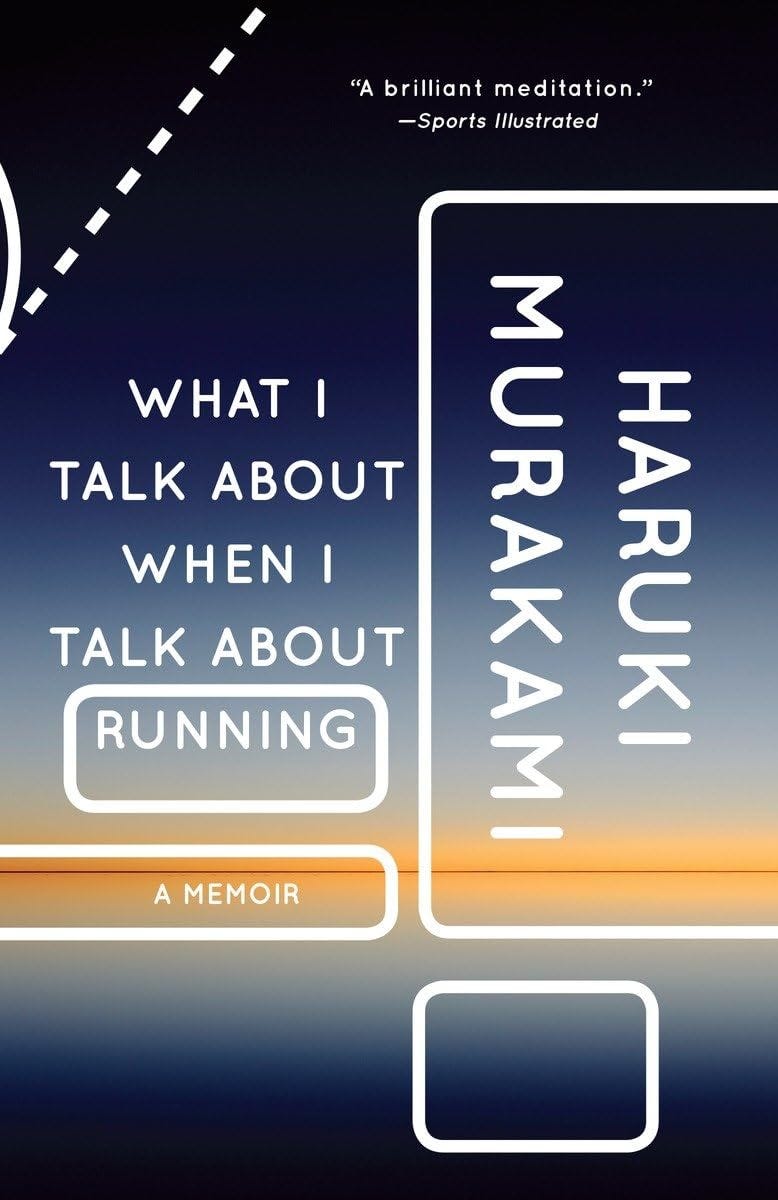“What do a novelist and a marathon runner have in common?”
At first glance, not much — one sits still for hours, the other moves relentlessly forward.
Haruki Murakami is best known for his surreal, emotionally resonant novels like Norwegian Wood and Kafka on the Shore, but fewer people know he’s also a devoted long-distance runner.
In What I Talk About When I Talk About Running, he invites us into a quiet space where writing and running blur into one rhythm: steady, solitary, and deeply personal. This isn’t just a memoir — it’s a meditation on effort, endurance, and the kind of inner clarity that only comes through repetition.

The Book in 3 Sentences
- In What I Talk About When I Talk About Running, Japanese novelist Haruki Murakami reflects on how long-distance running has influenced his approach to writing.
- Using his training for the New York City Marathon as a backdrop, he shares personal stories and thoughts on the discipline and routine both activities require.
- The memoir offers a quiet, thoughtful look at the connection between physical movement and creative work.
Impressions
How Did I Discover It?
I came across this book when I stayed at my high school roommate’s apartment last week and saw it on her bookshelf. I remembered she had brought it along when we met up for the Honolulu Marathon in 2023. As a writer who’s recently started getting into running, I was curious to see what an established Japanese author like Murakami had to say about the connection between the two.
Who Should Read It?
- Ideal for writers, runners, or creatives interested in the parallels between physical discipline and artistic work.
- A good fit for fans of Murakami who want a personal glimpse into his life and mindset.
- Recommended for readers who enjoy quiet, introspective memoirs with philosophical reflections on routine and perseverance.
How the Book Changed Me
1. The Discipline of Daily Effort: Writing and Running as Twin Practices
Murakami draws a deep parallel between long-distance running and writing: both are solitary pursuits that demand patience, rhythm, and resilience. Through this, he teaches that the essence of mastery isn’t brilliance but commitment. Whether it’s writing a novel or training for a marathon, progress comes from showing up daily — even when motivation fades. He describes this as “manual labor,” not glamorous or romantic, but honest, effortful work.
The takeaway here is that meaningful creation — whether artistic or physical — is less about talent and more about discipline, consistency, and the ability to endure discomfort over time.
2. Living in the Moment: Finding Fulfillment in the Process
Murakami’s reflections on running and writing reveal how deeply he values being present in the moment. Whether he’s describing the rhythm of his breath on a long run or the quiet focus of early-morning writing, he emphasizes that fulfillment comes from engaging fully with the process, not from chasing results. He finds meaning in the solitude, repetition, and physical exertion — what he calls “running in order to acquire a void.”
I find this resonates with ideas in The Power of Now by Eckhart Tolle, a separate book that explores how living in the present, rather than being trapped in thoughts of the past or future, can lead to a more peaceful and fulfilling life. Both books, though different in approach, remind us that the present moment is where clarity and contentment reside.
3. It’s Never Too Late to Begin — and Keep Beginning
Murakami didn’t start running until age 33, nor did he become a novelist because anyone told him he should. He just started — because something inside nudged him to try. The key lesson here is to trust your own internal compass and embrace new challenges, regardless of age, experience, or external approval.
His story reminded me of something my high school swim coach once said: “Life is a series of challenges and brief episodes of happiness and easy successes.” Murakami’s example reinforces this: real growth comes through persistence, self-awareness, and the willingness to keep showing up, especially when it gets hard.
My Top 3 Quotes
- I’m struck by how, except when you’re young, you really need to prioritize in life, figuring out in what order you should divide up your time and energy. If you don’t get that sort of system set by a certain age, you’ll lack focus and your life will be out of balance.
- Most runners run not because they want to live longer, but because they want to live life to the fullest. If you’re going to while away the years, it’s far better to live them with clear goals and fully alive than in a fog, and I believe running helps you do that. Exerting yourself to the fullest within your individual limits: that’s the essence of running, and a metaphor for life — and for me, for writing as well. I believe many runners would agree.
- Whether it’s good for anything or not, cool or totally uncool, in the final analysis what’s most important is what you can’t see but can feel in your heart. To be able to grasp something of value, sometimes you have to perform seemingly inefficient acts. But even activities that appear fruitless don’t necessarily end up so. That’s the feeling I have, as someone who’s felt this, who’s experienced it.
Reading Murakami’s reflections felt like running alongside a quiet but wise companion — one who doesn’t shout advice, but simply keeps pace and lets you draw your own conclusions.
Whether you’re a runner, a writer, or just someone trying to make sense of daily life, this book is a gentle reminder that real growth doesn’t happen in leaps, but in deliberate, almost invisible steps.
The road is long, the work often silent — but if you keep showing up, something shifts. And maybe that’s the real finish line.